One of the first things that visitors to Croatia notice is the country’s unique boomerang shape. The largest hunk sits at the top, stretching deep into Eastern Europe between Slovenia and Bosnia-Heregovina. The rest of Croatia curves downward in a narrow strip of coastal plain, beyond which steep mountains rise quickly from the shores of the Adriatic Sea. Residents of the inland areas of Croatia tend to be more influenced by the Ottoman culture of their neighbors in Bosnia-Herzegovia, while the culture of the coastal plain is more Mediterranean in nature.
It is not uncommon to hear people who live along the Croatian coast proclaim, “We are Dalmatians!” The term Dalmatian coast refers to the region that stretches from the city of Zadar in the north to Albania in the south. Though today most Dalmatians also consider themselves Croatians, they are quick to point out the cultural differences between themselves and those who live inland.
After a month on the Dalmatian coast, I began to notice the differences as well, starting with the language. The Croatian word for bakery is Pekarna, but on the coast it is simplified to Pekara. Many words are similarly simplified, perhaps because the coast was ruled by Venice for centuries, while inland regions were settled by Slavic tribes. And like Italians, family is paramount for Dalmatians, with multi-generational extended families often living in the same home.
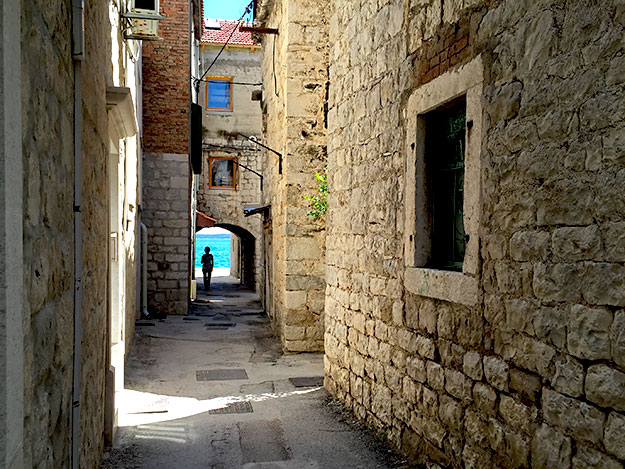
Food is another big difference. Every Dalmatian has a large garden that provides fresh produce during the summer and canned goods for winter. No self-respecting Dalmatian would think of buying a tomato in a store. And the milder climate along the coast makes for a long growing season, so fresh fruits and vegetables are used abundantly in coastal cuisine.
I didn’t realize it at the time, but it was these differences that most factored in my decision to spend the month of June on the Dalmatian coast this year. The town of Split, with its charming waterfront Riva (promenade) had worked its charms on me the prior year (read how I fell in love with Split, Croatia here). This time around, I was determined to explore the rest of the Dalmation coast.

I began in the far south, in Dubrovnik. The early history of Dubrovnik is murky. Not even the experts agree on its founding. Some believe it originated in the 7th century AD, when refugees from Roman Epidaurum built their new settlement on the small island of Laus. Recent archeological work has unearthed the foundations of a large Byzantine basilica and old city walls that existed in the 8th century, indicating that there was an established settlement where Dubrovnik now stands well before the 7th century. Some even insist that Dubrovnik existed before the common era, as a Greek trading and maritime center.
Whichever theory is correct, it is clear that Dubrovnik has survived a convoluted history. Over the centuries it has been allied with or controlled by the Ostrogothic Kingdom; the Byzantine Roman Empire; Venice; the Kingdom of Hungary; the maritime republic of Ancona that is part of present-day Italy; the Ottoman Empire; Napoleonic France; the British Empire; the Austro-Hungarian Empire; the Kingdom of Serbs, Croats, and Slovenes; and finally, Yugoslavia. With the plethora of invasions and political struggles it suffered, it’s no wonder the city surrounded itself with thick stone walls.
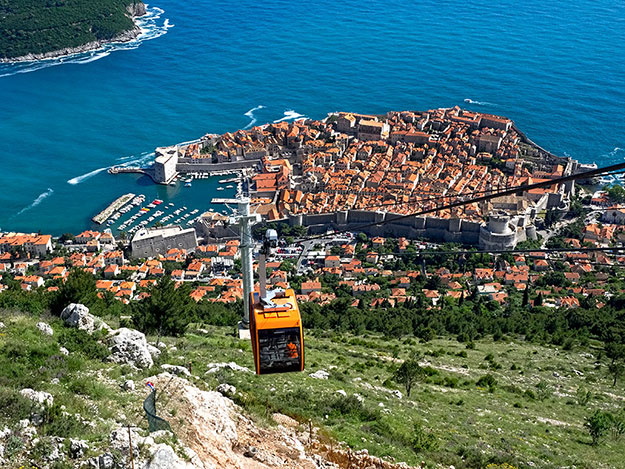
I walked the entire 1.2 mile length along the upper battlements of these walls one sunny morning. Each turn brought a different view over the Old Town, with its stately domed churches and sea of red-tiled roofs. Here and there I spotted damage left by the Yugoslav War of 1991-92, but most buildings have been totally restored. To learn more about the city’s recent war-torn history, I took the cable car to the top of Mount Srd to visit the war museum at Fort Imperial. Built in 1806-1816 during the Napoleonic War, the fort was the scene of the longest siege suffered in Dubrovnik, and the battered walls stand in testament to the ferocity of the fighting.
After three days in Dubrovnik I had seen much of what the city had to offer, so I took a bus to Split. I was glued to the window for the next five hours, drinking in some of the world’s most gorgeous coastal scenery. Sheer mountain faces plunged thousands of feet into the cobalt waters of the Adriatic. Pretty villages, with their ancient stone houses, popped up wherever the land flattened out. Curves and switchbacks offered tantalizing glimpses of pocket beaches tucked between soaring cliffs.
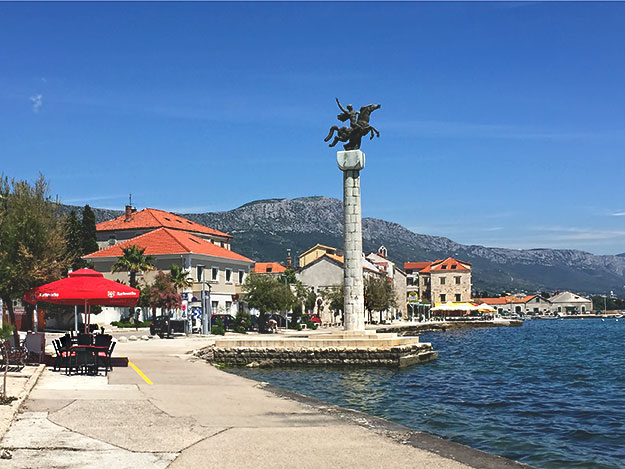
I continued half an hour south of Split, to a sweeping concave bay where seven medieval villages combine to form the city of Kaštela. When Venetians lost control of the area in 1797, these settlements were exposed to Ottoman invasion. The Catholic Church, with support and funding from local noble families, approved the building of fortifications in each town to protect citizens from raids. Some were simple cylindrical towers while others were more elaborate, but they were all considered to be castles. The names of the villages (Kaštel Stafilic, Kaštel Novi, Kaštel Stari, Kaštel Lukšic, Kaštel Kambelovac, Kaštel Gomilica, and Kaštel Sucurac), are references to those castles.
My home for the month was Villa Mira, a fully refurbished historic stone cottage in Kaštel Novi. The apartment was tucked behind the church and just steps from the town square and the sea. Like a true Croatian, I began each day at Imas Caffe Bar, sipping an Americano or Cappucino while watching the fishing boats bob in the harbor. Coffee is an institution everywhere in Croatia, and it is not uncommon for people to stop two or three times a day for an espresso break. The local caffe bar is where news is shared, friends connect, and gossip is spread. Every town has several, no matter how small.
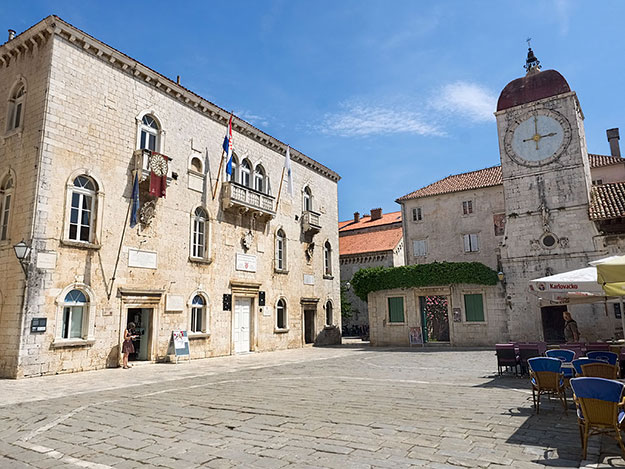
Some mornings I strolled over to the square, where stooped elderly women in long black dresses and fringed babushkas peddled their produce. Each day brought different offerings: fresh shelled peas, giant heads of red leaf lettuce, luscious deep green kale, peaches, cherries, and juicy fresh figs. In the afternoon, I taught myself to cook a few simple dishes: pasta with pesto and grated local artisan cheese or a zucchini frittata made with eggs from my landlord’s farm that were so fresh the yolks were bright orange. And the tomatoes! Giant, juicy, and so tasty that I ate them in thick slices, topped with sliced mozzarella and drizzled with my landlord’s homemade olive oil.

One day I explored the city of Trogir, a UNESCO World Heritage Site that is the best-preserved Romanesque-Gothic site in Central Europe. The medieval old town is contained on a small island, which made it easy to see everything during a day trip.
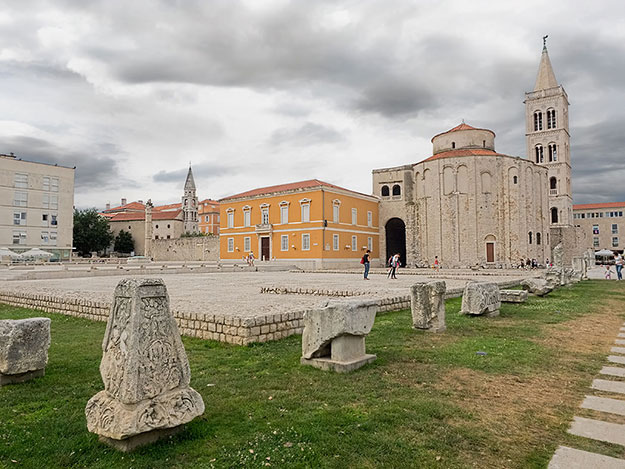
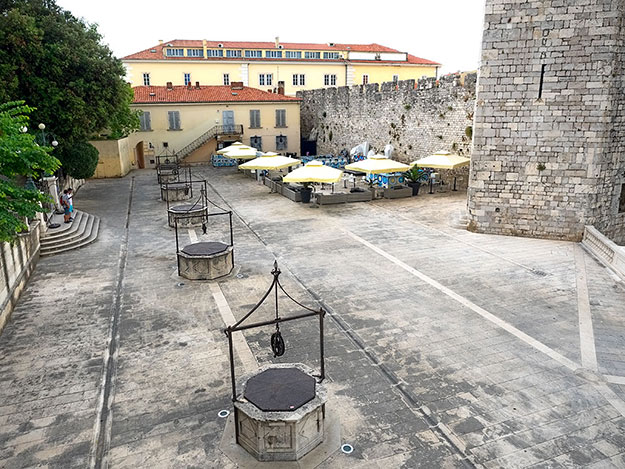
Another day, friends took me to see Zadar, the city that marks the northernmost reaches of Dalmatia. The walled old town area is home to numerous historic stone churches and a Roman Forum, where archeological artifacts are on display. Even more fascinating was the Riva, a broad promenade that stretches along the Adriatic Sea. Rather than clutter it with sidewalk cafes or kiosks selling souvenirs, Zadar has embedded pipes in the concrete retaining wall. Waves crashing against the pipes of this “Sea Organ” produce a soulful, moaning music reminiscent of whales singing.
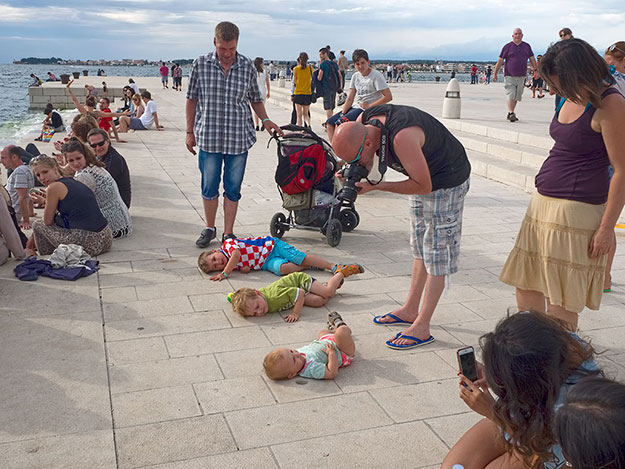
The Dalmatian coast has more to offer that I have not yet seen. Šibenik is another coastal city that gets rave reviews, and I haven’t visited any of the more than 500 islands and islets that lie offshore. Croatian friends tell me the islands offer healing mineral springs, botanical gardens, and some of the country’s best beaches. I can see that I have my work cut out for me. To see it all will require many visits over multiple years. I may never be able to explore the entire Dalmatian coast of Croatia, but I have seen enough to know that the fierce pride locals have for their culture and scenery is more than justified. It’s no wonder they are quick to say, “I am a Dalmatian.”

Sibenik has amazing little streets , even more amazing than Dubrovnik and split in my opinion. I took the time to go to turn away from the main old streets and into the hidden alleyways and what I discovered was amazing. Krka waterfalls are stunning smaller version of Croatia’s iconic Plitvice lakes. This region around sibenik is stunning. The town of Betina on the island of Murter is gorgeous and is a great connection point to the Kornati island archipelago. Also the Solaris camp beach strip is amazing with the most amazing outdoor restaurant I have seen called staro selo or old village. Check it out its stunning. Croatia too is my favourite part of ghe world and have now visited numerous times from Australia
Hi Dan: Thanks so much for all the info. I’m really looking forward to going back next summer to explore more of Croatia and Sibenik is high on my list.
Looks like a really beautiful place. I want to press my ears to the ground there now!
It is a wonderful place – one of my favorite places in the world. I’d be curious to know what you hear when you press your ear to the ground 🙂
I like that you mentioned the multiple coffee breaks, it just captured my attention too when I visited Croatia.
I’m a coffee addict, Iris, so I really appreciated the custom 🙂
Šibenik is amazing. UNESCO cathedral is enough reason to visit, but there’s so much more. And Krka national park a few kms away! One of the finest days of my entire life was spent there!! 🙂
Hi Jon: Šibenik is definitely on my wish list, but had forgotten about Krka National Park. Now it’s on the list too. Thanks for sharing.